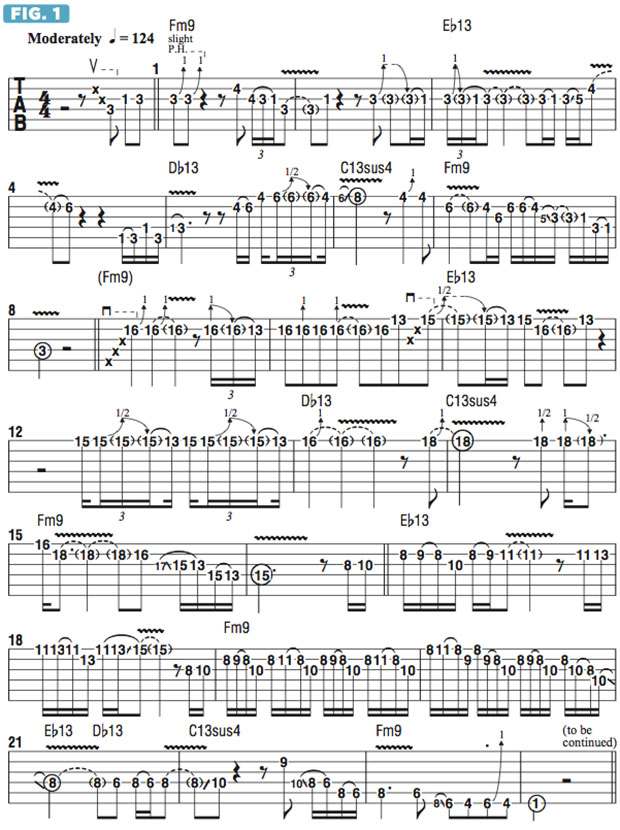Bluesy SRV, Betts and Page-Style Soloing Over a Mid-Sixties Jazz Classic

As I promised last month, I’m going to demonstrate some cool licks to play over the chord changes to Horace Silver’s mid-Sixties jazz classic “Song for My Father.”
As you recall, the composition features a cool, laid-back bossa nova groove and loosely spaced chord changes that make it a great jam tune for rock and blues guitarists looking to get into jazz.
For my first chorus of soloing—the term is jazz and blues slang for one complete song cycle, which in this case is a 24-bar AAB form comprised of three eight-bar sections—I thought it would sound good to begin by playing sparse, bluesy phrases (something no one will ever fault you for doing).
The sound of the chord progression brought to my mind Stevie Ray Vaughan’s tasteful, understated lead playing at the end of David Bowie’s 1983 hit song “Let’s Dance,” and I thought, What would SRV play here? FIGURE 1 is what I came up with.
For the first A section, bars 1–8, I stay in the lower area of the neck, where everything sounds bright and twangy, and play bluesy, bendy licks based on the F minor pentatonic scale (F Ab Bb C Eb), which is structurally identical to the more guitarist-familiar E minor pentatonic (E G A B D), only one half step, and one fret, higher on the fretboard, which helps tremendously with the visualization of patterns and shapes.
Although it may seem as if I’m just arbitrarily playing blues licks here, I’m thoughtfully emphasizing and pausing on certain notes the “agree with” each chord. For example, in bar 3, over Eb13 (see last month’s column for chord voicings for this tune), I’m sitting on Bb, the fifth of that chord. Over Db13, in bar 6, I land on the scale’s F root note, which happens to be the third of that chord. (Remember, the third is always a great note choice!) In bar 6, I slide up to the root note of C13sus4, C, which is the fifth of F minor pentatonic. It’s all about note placement.
In the second A section, bars 9–17, for which the chord progression from bars 1–8 repeats, I move higher up the neck and play more F minor pentatonic-based licks, using lots of bends and vibratos. I also introduce another note to our tonal palette, G, which changes the scale to the slightly more sophisticated-sounding F minor hexatonic (F G Ab Bb C Eb). Over Fm9, G functions as the second, or ninth, and it sounds great over that chord. Over Eb13, G becomes the third, and I exploit that relationship with the wailing bend licks in bars 11 and 12.
All the latest guitar news, interviews, lessons, reviews, deals and more, direct to your inbox!
For the B section, or bridge, bars 17–24, I further exploit G over Eb13 (bars 17 and 18) Dickey Betts style, as well as over Fm9 (bars 19 and 20) in a way that brings to mind Jimmy Page’s signature use of pull-offs. (Page’s huge influence on me shamelessly shines through in the “Stairway to Heaven” lick in bar 12 as well.)
Be sure to check out this column’s video lesson for some helpful performance tips. Next month, we’ll really get inside the tune’s changes and rhythm with some angular, bebop-style 16th-note lines.

Over the past 30 years, Jimmy Brown has built a reputation as one of the world's finest music educators, through his work as a transcriber and Senior Music Editor for Guitar World magazine and Lessons Editor for its sister publication, Guitar Player. In addition to these roles, Jimmy is also a busy working musician, performing regularly in the greater New York City area. Jimmy earned a Bachelor of Music degree in Jazz Studies and Performance and Music Management from William Paterson University in 1989. He is also an experienced private guitar teacher and an accomplished writer.

